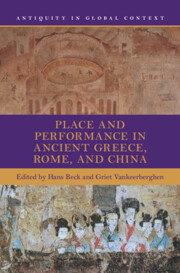Book contents
- Place and Performance in Ancient Greece, Rome, and China
- Antiquity in Global Context
- Place and Performance in Ancient Greece, Rome, and China
- Copyright page
- Contents
- Figures
- Tables
- Contributors
- Series Editors’ Preface
- Editors’ Preface
- Introduction
- Part I Crafting Space and Place
- Part II Performances of Power
- Part III Urban Places
- Part IV Fringe Places and Endpoints
- Chapter 11 Imitating the Emperor?
- Chapter 12 Traces of Han and Roman Frontiers
- Chapter 13 Money and the Dead
- Chapter 14 Displaying the Dead
- Index
- References
Chapter 12 - Traces of Han and Roman Frontiers
Documents from Vindolanda and Jianshui Jinguan
from Part IV - Fringe Places and Endpoints
Published online by Cambridge University Press: 28 November 2024
- Place and Performance in Ancient Greece, Rome, and China
- Antiquity in Global Context
- Place and Performance in Ancient Greece, Rome, and China
- Copyright page
- Contents
- Figures
- Tables
- Contributors
- Series Editors’ Preface
- Editors’ Preface
- Introduction
- Part I Crafting Space and Place
- Part II Performances of Power
- Part III Urban Places
- Part IV Fringe Places and Endpoints
- Chapter 11 Imitating the Emperor?
- Chapter 12 Traces of Han and Roman Frontiers
- Chapter 13 Money and the Dead
- Chapter 14 Displaying the Dead
- Index
- References
Summary
The sites of Vindolanda in Great Britain and Jianshui Jinguan, present-day Gansu, have produced exciting paleographic evidence pertaining to the borders of the Roman and the Han Chinese empires, respectively. Archaeological excavations at both sites have brought to light many written sources, on inscribed thin tablets and strips of locally available woods, that cast a spotlight on what their authors associated with their assignment in the fringes of empire. Imperfect analogues as these two locations are, rich in cultural idiosyncrasy, Charles Sanft undertakes a comparative analysis that brings both data sets into close conceptual conversation. He begins his discussion with observations on the abstract nature of ancient borders: neither tangible nor “real,” borders were, Sanft argues, a projection of culturally encoded imaginaries. Following this investigative vein, he then explores the spatial essence of Roman and Han Chinese borders. Before turning to the actual sites and documents, Sanft reminds his audience of the convoluted relation between space and place; the latter is understood as a local environment that can be experienced by individuals who are, in turn, aware of the distinct experience of place. The examination of the Vindolanda tablets and Jianshui Jinguan reveals an absence of this type of experience from the written records; hence, the imagination of border postings does not find articulation in terms of experience. Sanft translates this discovery into extensive and indeed paramount conclusions on the Roman and the Han Chinese understanding of borderlands, which was subject to imaginations of far-flung imperial spaces rather than actual engagements with place.
- Type
- Chapter
- Information
- Place and Performance in Ancient Greece, Rome, and China , pp. 378 - 409Publisher: Cambridge University PressPrint publication year: 2024

